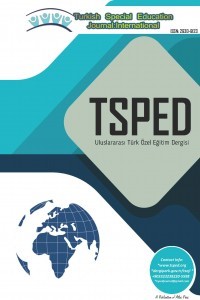ATTITUDES AND KNOWLEDGE OF SPECIAL EDUCATION TEACHERS ON LANGUAGE AND SPEECH DISORDERS IN CHILDREN
Special education teachers are important team members in the prevention and intervention of speech and language disorders. The knowledge and attitudes of special education teachers about language and speech disorders are important for the evaluation, development and progress of the child with special needs. The aim of this research is to determine the attitudes and knowledge of special education teachers towards language and speech disorders in children. 106 special education teachers participated in the study. In this research, which is a descriptive study, survey model was used. “Attitude and Knowledge Questionnaire towards Language and Speech Disorders” was used as a data collection tool in the study. The data obtained through the questionnaire were collected to reveal the knowledge of special education teachers on the subject.The data collected from the research were analyzed with the Statistical Package Program for Social Sciences (SPSS 23.0). The findings obtained from the research are presented together with the tables in the form of frequency and percentage values and descriptive findings. More research is needed on special education teachers regarding language and speech disorders that are common among disability groups.
Anahtar Kelimeler:
knowledge and attitude, special education, special education teacher, Speech and language disorders, knowledge and attitude, special education, special education teacher, Speech and language disorders, knowledge and attitude, special education, special education teacher
Keywords:
Keywords: Speech and language disorders, knowledge and attitude, special education, special education teacher, Speech and language disorders, knowledge and attitude, special education, special education teacher,
___
- Aydın Uysal, A., & Tura, G. (2018). Öğretmen adaylarının çocuklardaki dil ve konuşma bozukluklarına yönelik tutum ve bilgilerinin değerlendirilmesi. Kocaeli Üniversitesi Eğitim Dergisi, 1(1), 13-22. https://doi.org/10.33400/kuje.425174
- Billingsley, B., & Bettini, E. (2019). Special education teacher attrition and retention: A review of the literature. Review of Educational Research, 89(5), 697-744. https://doi.org/10.3102/0034654319862495
- Bora, İ., & Toğram, B. (2018). Ebeveyn ve öğretmenlerin konuşma bozukluklarına yönelik tutum ve bilgileri: Lefkoşa örneklemi. Dil Konuşma ve Yutma Araştırmaları Dergisi, 1(1), 31-49.
- Brown, J. (2011). ASHA and the evolution of telepractice. Perspectives on Telepractice, 1(1), 4-9. https://doi.org/10.1044/tele1.1.4
- Büyükköse, D. (2020). Özel eğitim ve rehabilitasyon merkezlerinde dil ve konuşma terapisi hizmetinin sunulma süreci: Bir eylem araştırması [Unpublished doctoral dissertation]. Anadolu University, Education Sciences Institute,Turkey.
- Büyüköztürk, Ş., Kılıç Çakmak, E., Akgün, Ö. E., Karadeniz, Ş., & Demirel, F. (2014). Bilimsel araştırma yöntemleri. Ankara: Pegem Akademi.
- Çağlar, Y. S., & Çiyiltepe, M. M. (2019). Dil ve konuşma terapistleri ve özel eğitim öğretmenlerinin oral-motor egzersizlerini kullanımlarının karşılaştırılması. Dil Konuşma ve Yutma Araştırmaları Dergisi, 2(1), 53-76.
- Erdem, İ. (2013). Konuşma eğitimi esnasında karşılaşılan konuşma bozuklukları ve bunları düzeltme yolları. Adıyaman Üniversitesi Sosyal Bilimler Enstitüsü Dergisi Türkçenin Eğitimi Öğretimi Special Issue, 6(11), 415-452. https://doi.org/10.14520/adyusbd.453
- Etikan, I., Musa, S. A., & Alkassim, R. S. (2016). Comparison of convenience sampling and purposive sampling. American Journal of Theoretical and Applied Statistics, 5(1), 1-4.
- Feldman, H. M. (2019). How young children learn language and speech. Pediatrics in Review, 40(8), 398-411. https://doi.org/10.1542/pir.2017-0325
- Friehe, M. J., Bloedow, A., & Hesse, S. (2003). Counseling families of children with communication disorders. Communication Disorders Quarterly, 24(4), 211-220. https://doi.org/10.1177/15257401030240040701
- Konca, H. F. (2021). Okul öncesi dönemde birincil dil ve konuşma sorunu olan çocuklara uygulanan müdahalelerde ebeveyn ve dil ve konuşma terapistinin rolü [Unpublished master thesis]. İstanbul Medipol University, Health Sciences Institute, İstanbul, Turkey.
- McLeod, S., & McKinnon, D. H. (2007). Prevalence of communication disorders compared with other learning needs in 14 500 primary and secondary school students. International Journal of Language & Communication Disorders, 42(1), 37-59. https://doi.org/10.1080/13682820601173262
- Powell, R. K. (2018). Unique contributors to the curriculum: From research to practice for speech-language pathologists in schools. Language, Speech, and Hearing Services in Schools, 49(2), 140-147. https://doi.org/10.1044/2017_LSHSS-17-0059
- Prakash, S. S. (2012). Inclusion of children with hearing impairment in schools: A survey on teachers’ attitudes. Disability, CBR & Inclusive Development, 23(3), 90-111.
- Reder, P., & Duncan, S. (2003). Understanding communication in child protection networks. Child Abuse Review: Journal of the British Association for the Study and Prevention of Child Abuse and Neglect, 12(2), 82-100. https://doi.org/10.1002/car.787
- Sharp, H. M., & Hillenbrand, K. (2008). Speech and language development and disorders in children. Pediatric Clinics of North America, 55(5), 1159-1173.
- Sunderajan, T., & Kanhere, S. V. (2019). Speech and language delay in children: Prevalence and risk factors. Journal of Family Medicine and Primary Care, 8(5), 1642.
- Toğram, B. & Maviş, İ. (2009). Aileler, öğretmenler ve dil ve konuşma terapistlerinin çocuklardaki dil ve konuşma bozukluklarına yönelik tutum ve bilgilerinin değerlendirilmesi. Ankara Üniversitesi Eğitim Bilimleri Fakültesi Özel Eğitim Dergisi, 10(01) , 71-85. https://doi.org/10.1501/Ozlegt_0000000134
- Topbaş, S., Konrot, A., & Ege, P. (2002). Dil ve konuşma terapistliği. Eskişehir: Anadolu University Printing.
- ISSN: 2630-6123
- Başlangıç: 2018
- Yayıncı: Atlas att. dış tic. bilg. kırt. ve gd. ltd. şti
Sayıdaki Diğer Makaleler
İŞİTME YETERSİZLİĞİ OLAN BİREYLERİN TOPLUMSAL ALANDA YAŞADIKLARI İLETİŞİM SORUMLARI: KKTC ÖRNEĞİ
ÖZEL EĞİTİME İHTİYACI OLAN İLKOKUL ÖĞRENCİLERİNİN AĞAÇ KAVRAMINA İLİŞKİN METAFORİK ALGILARI
KREŞ VE GÜNDÜZ BAKIMEVLERİNDE ÇALIŞAN ÇOCUK BAKICILARININ GÖZÜNDEN ÖZEL GEREKSİNİMLİ BİREYLER
Kevser KILIÇ, Nesime Kübra TERZİOĞLU, Muratcan AKBIYIK
Güliz KAYMAKCI, Bariş DOĞRUKÖK, Gözde DUMAN AKIN
ATTITUDES AND KNOWLEDGE OF SPECIAL EDUCATION TEACHERS ON LANGUAGE AND SPEECH DISORDERS IN CHILDREN
